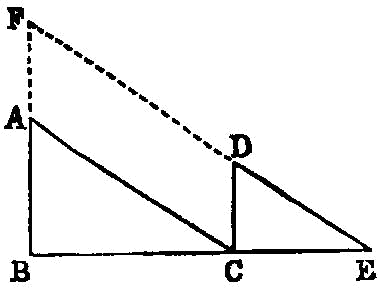Proposition 6.4

In equiangular triangles the sides about the equal angles are proportional, and those are corresponding sides which subtend the equal angles.
Let ABC, DCE be equiangular triangles having the angle ABC equal to the angle DCE, the angle BAC to the angle CDE, and further the angle ACB to the angle CED; I say that in the triangles ABC, DCE the sides about the equal angles are proportional, and those are corresponding sides which subtend the equal angles.
For let BC be placed in a straight line with CE.
Then, since the angles ABC, ACB are less than two right angles, [I. 17] and the angle ACB is equal to the angle DEC, therefore the angles ABC, DEC are less than two right angles; therefore BA, ED, when produced, will meet. [I. Post. 5]
Let them be produced and meet at F.
Now, since the angle DCE is equal to the angle ABC, BF is parallel to CD. [I. 28]
Again, since the angle ACB is equal to the angle DEC, AC is parallel to FE. [I. 28]
Therefore FACD is a parallelogram; therefore FA is equal to DC, and AC to FD. [I. 34]
And, since AC has been drawn parallel to FE, one side of the triangle FBE, therefore, as BA is to AF, so is BC to CE. [VI. 2]
But AF is equal to CD; therefore, as BA is to CD, so is BC to CE, and alternately, as AB is to BC, so is DC to CE. [V. 16]
Again, since CD is parallel to BF, therefore, as BC is to CE, so is FD to DE. [VI. 2]
But FD is equal to AC; therefore, as BC is to CE, so is AC to DE, and alternately, as BC is to CA, so is CE to ED. [V. 16]
Since then it was proved that, as AB is to BC, so is DC to CE, and, as BC is to CA, so is CE to ED; therefore, ex aequali, as BA is to AC, so is CD to DE. [V. 22]
Therefore etc. Q. E. D.
